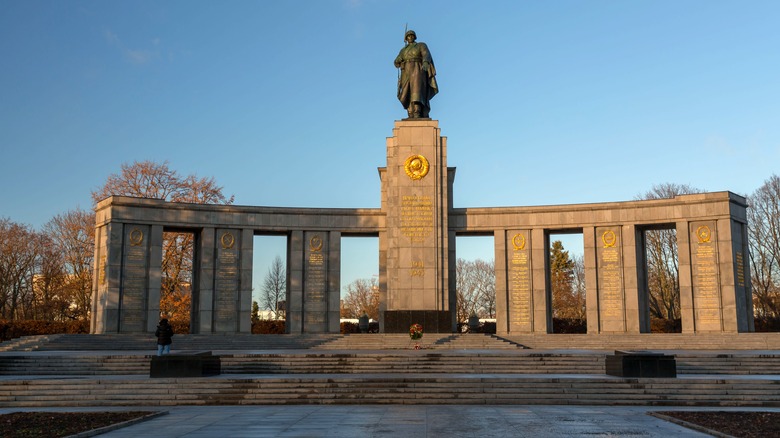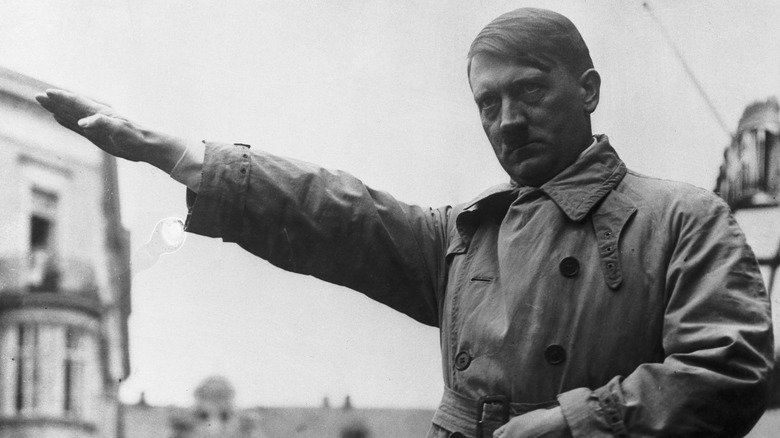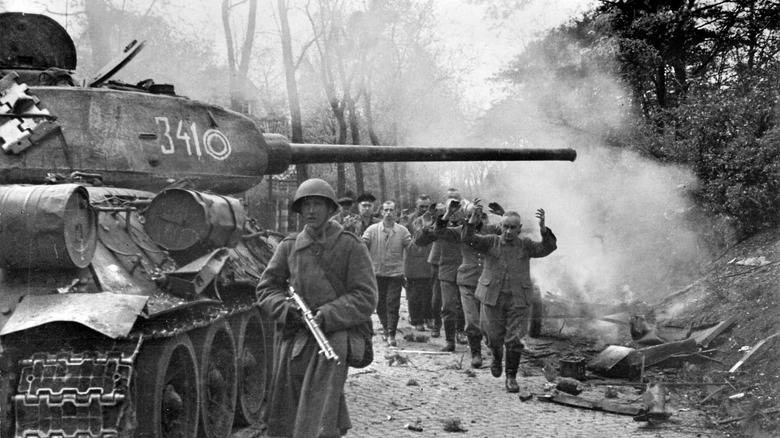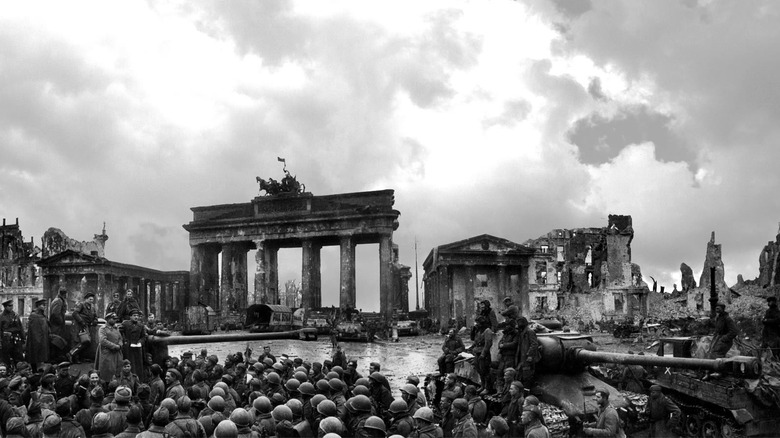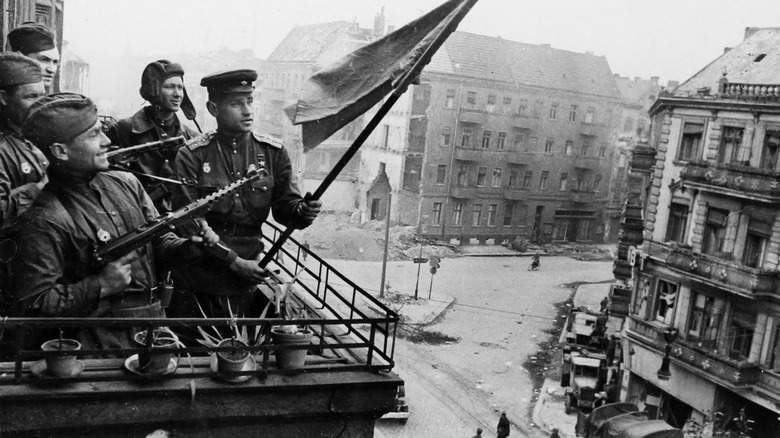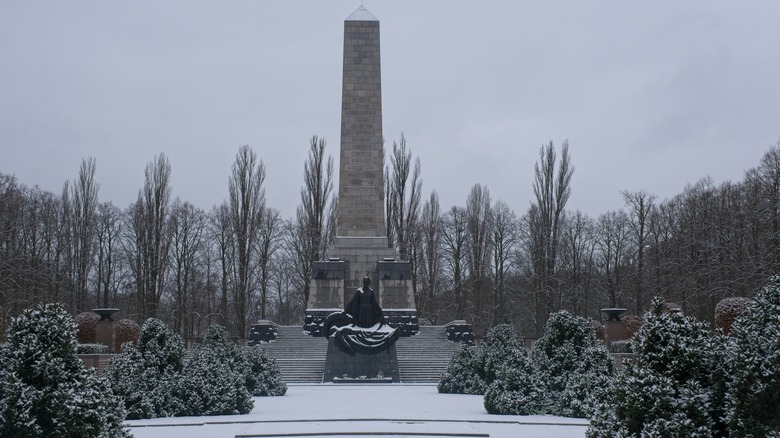What Happened To The Bodies At The Battle Of Berlin?
The following article includes graphic descriptions of sexual assault and murder.
Dictator Adolf Hitler made numerous fatal wartime choices ahead of Germany's defeat at the end of World War II, not the least of which was invading his once ally, Russia. Seeking Soviet raw materials as much as he did glory for conquering an unconquerable landmass, Hitler committed enormous resources to invading Russia via Operation Barbarossa (June to December 1941) and later the Battle of Stalingrad (July 1942 to February 1943). But come April 1945, the Soviet Union got its chance at revenge at the Battle of Berlin, the final strike that decapitated the German war machine in May. The clash left hundreds of thousands dead, including Hitler, who killed himself on April 30 before the battle ended.
Allied forces pulverized Berlin with repeated bombings before Soviet troops rolled into the capital on April 16. By April 21 the Soviets were engaged in door-to-door fighting, and by May 2, it was all over. While not as devastating of a loss as a colossal conflict like the Battle of Stalingrad (almost 800,000 dead, wounded, missing, or captured for Axis powers alone), over 80,000 Soviet soldiers and 50,000 German soldiers were killed in the Battle of Berlin. Beyond these combatants, about 125,000 residents of Berlin died in the conflict, aside from however many became refugees. Some German civilians suffered horrific atrocities at the hands of Soviet forces before death. Some soldiers and residents simply vanished and were never recovered. Other dead made their way to cemeteries or were memorialized.
Germany's defeat and Hitler's remains
While Adolf Hitler was never the most stable of persons, his decision-making in Germany's World War II war efforts grew increasingly erratic, risky, and desperate as time went on. It's likely that he knew the Axis powers would lose the war as early as November 1942. And yet, the Western Front persisted for another two and half years until Germany officially declared surrender on May 7, 1945. Not long before that, on April 30, Hitler took his own life during the Battle of Berlin.
As the MI5 website says, a Soviet army of about 2.5 million reached Berlin by April 1945, and Hitler fled into his underground Führerbunker in the capital. He occasionally emerged aboveground to shake hands with troops whom he sent to die in combat with the Soviets. On April 29, he finished drafting his will and married his mistress Eva Braun. The next day they took cyanide pills, and Hitler shot himself.
Hitler and Braun were carried aboveground, doused in petrol, set on fire, and buried in a bomb crater. Soviet troops dug up the remains and took them to Magdeburg in East Germany. Only in 2017 did the Russian Federal Security Service allow researchers to examine what remained of Hitler's body — teeth, as well as jaw and skull fragments. As Phys.org explains, the dental records, right down to the bad hygiene, match the Führer's. "The teeth are authentic, there is no possible doubt," research lead Philippe Charlier told AFP. Thus ends the tale of Hitler's body.
The Battle of Berlin's dead combatants
Berlin Experiences explains that some Soviet soldiers who died at the Battle of Berlin were buried where they fell. Some were sent back to the USSR to families and buried. Some were collected into mass graves and memorialized at three locations in Berlin: the Tiergarten, Treptower Park, and Schönholzer Heide. The memorial/grave at Treptower park houses about 7,000 Soviet soldier remains, the one at the Tiergarten houses about 2,500 soldiers, and the one at Schönholzer Heide houses about 13,200. That accounts for about 22,700 Soviet soldiers out of 80,000 total dead. It's unclear what happened to the rest of the dead, or how many of those are considered missing.
German soldiers faced an even more unpredictable end. They reside in small cemeteries around Berlin like the Lilienthalstraße German War Cemetery, which houses exactly 4,935 soldiers and civilians. Invalidenfriedhof Cemetery, housing remains dating back to 1813, has a mass grave of 34 German soldiers and civilians, but on orders from Allied powers, some grave markers were removed. Other German soldiers rest slightly outside of Berlin in Halbe Forest Cemetery because they fought the Soviet advance into Berlin. Some 500 or 600 people were found there in 2013, and remains are still being discovered in the nearby village of Klessin in 2019. Meanwhile, the Soviet Union took up to 3.5 million German POWs over the course of World War II, including an unknown amount during the Battle of Berlin. About 1.5 million of these POWs remained unaccounted for even by 1950.
[Featured image by Mil.ru via Wikimedia Commons | Cropped and scaled | CC BY 4.0]
The Battle of Berlin's dead civilians
Throughout World War II, residents of Berlin attempted to live their lives as best as possible, even in the middle of conflict. If about 130,000 combined German and Soviet troops died during the Battle of Berlin, almost the same number of civilians died, at 125,000. This number is as good of an estimate we're likely to get. It isn't hard to envision the complete chaos of civilians racing around a city under fire — trying to flee artillery explosions and stray bullets as they make their way to the city outskirts and huddle near a tree, children and belongings in arm.
We also can't say how many civilians went missing, have unidentifiable remains, went unaccounted for in recordkeeping, etc. It's also impossible to even say which groups of civilians are buried where. Not even the German government is able to make that distinction, as Berlin's Senate Department for Urban Mobility, Transport, Climate Action and the Environment explains. German non-combatants of all types — citizens and non-citizens, refugees, those slaughtered in concentration camps, those who died after the war under Soviet rule, and more — are buried in 170 cemeteries across Berlin and in regions the city owns. There are 150,000 graves total, and it's unclear how many of these died during the Battle of Berlin or anywhere else, for that matter. And of course, much like German soldiers, some ended up in Soviet POW camps.
[Featured image by Yevgeny Khaldei via Wikimedia Commons | Cropped and scaled | Implementation Act for Book IV of the Civil Code of the Russian Federation]
The Soviet rape of Berlin
Soviet forces in Berlin wound up inflicting savage, debased crimes against German citizens. The BBC describes eyewitness accounts from lieutenant Vladimir Gelfand, a Soviet Jew from Ukraine, who in his diary describes passing entire villages razed by German soldiers on the way to Berlin. This includes desecrated bodies that exhibited evidence of rape. But in a short time, Gelfand describes his Soviet comrades committing the same kinds of crimes against German civilians, particularly women.
In one instance he comes across a young German girl who had recently been gang raped by 20 men in front of her mother. Other times Soviet soldiers suggested stabbing "German female cats" (female soldiers) through the genitals. One Battle of Berlin memorial in the capital's Treptower Park has been dubbed the "Tomb of the Unknown Rapist." It's impossible to account for how many such deplorable acts occurred, how many women were killed, or where those women were buried. But like any other battle in history, such people suffered and died at the Battle of Berlin and have never been found, laid to rest, or honored in memorials.
[Featured image by Ефим Копыт, Борис Вельяшев (ТАСС) via Wikimedia Commons | Cropped and scaled | Implementation Act for Book IV of the Civil Code of the Russian Federation]
Honorary cemeteries to the fallen
There are numerous memorials to those who fell at the Battle of Berlin, both to commemorate the dead and to serve as "honorary cemeteries" for the forever-missing, as Digital Cosmonaut puts it. There are 12 such memorials in Berlin, placed like signposts around the city at prominent public places. Interestingly, these were all erected in Soviet-held East Germany, which was districted in the years following World War II and remained in Soviet hands until the Berlin Wall fell in 1989, two years before the USSR collapsed in 1991. But while these monuments represent pro-Soviet propaganda, they remain significant to remembering the loss of life at the Battle of Berlin.
The three most prominent of these memorials were also the first three built. As mentioned, these serve as actual cemeteries. Per Berlin's Senate Department for Urban Mobility, Transport, Climate Action and the Environment, the memorial at Tiergarten Park was first chosen for its proximity to the Brandenburg Gate and nearby Reichstag, the German legislative building. There's another monument east of the Tiergarten inside Treptower Park, and a third at another park to the north, Schönholzer Heide.
As you can imagine, these Berlin war memorials represent a potential sticking point between Germany and Russia. In 1990, Russian President Mikhail Gorbachev and German Chancellor Helmut Kohl signed a peace treaty between the two nations following the crumbling of the Berlin Wall. As part of the treaty, the USSR. insisted that its Soviet-built Battle of Berlin war memorials be well-maintained. Germany has upheld this promise ever since.
If you or anyone you know has been a victim of sexual assault, help is available. Visit the Rape, Abuse & Incest National Network website or contact RAINN's National Helpline at 1-800-656-HOPE (4673).
